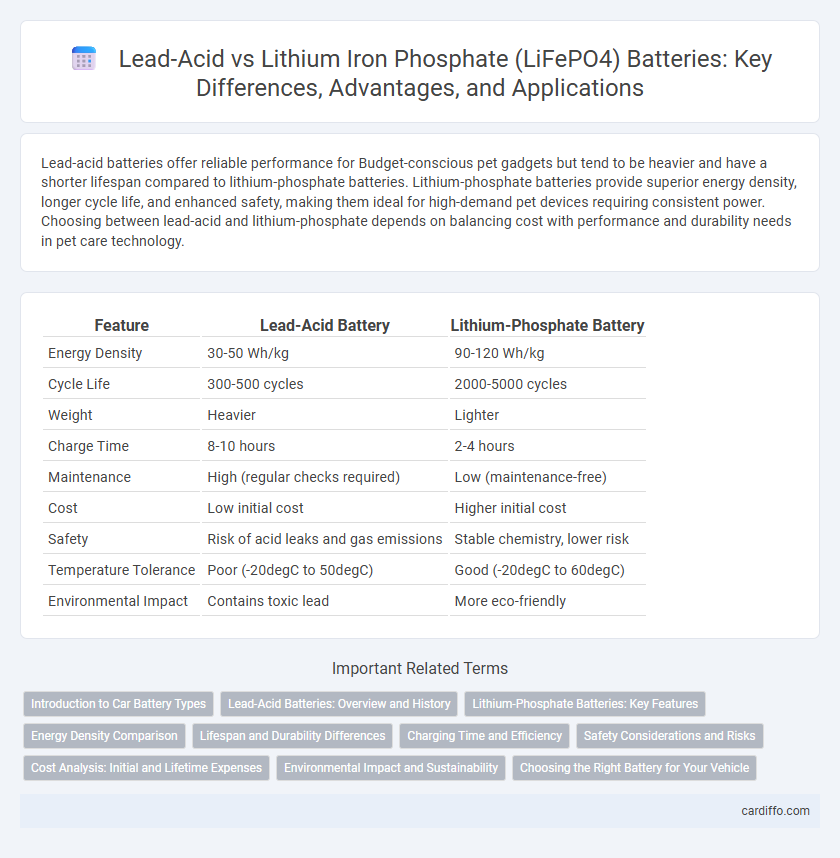Lead-acid batteries offer reliable performance for Budget-conscious pet gadgets but tend to be heavier and have a shorter lifespan compared to lithium-phosphate batteries. Lithium-phosphate batteries provide superior energy density, longer cycle life, and enhanced safety, making them ideal for high-demand pet devices requiring consistent power. Choosing between lead-acid and lithium-phosphate depends on balancing cost with performance and durability needs in pet care technology.
Table of Comparison
| Feature | Lead-Acid Battery | Lithium-Phosphate Battery |
|---|---|---|
| Energy Density | 30-50 Wh/kg | 90-120 Wh/kg |
| Cycle Life | 300-500 cycles | 2000-5000 cycles |
| Weight | Heavier | Lighter |
| Charge Time | 8-10 hours | 2-4 hours |
| Maintenance | High (regular checks required) | Low (maintenance-free) |
| Cost | Low initial cost | Higher initial cost |
| Safety | Risk of acid leaks and gas emissions | Stable chemistry, lower risk |
| Temperature Tolerance | Poor (-20degC to 50degC) | Good (-20degC to 60degC) |
| Environmental Impact | Contains toxic lead | More eco-friendly |
Introduction to Car Battery Types
Lead-acid and lithium-phosphate batteries are two primary types used in automotive applications, each offering distinct advantages and performance characteristics. Lead-acid batteries provide reliable starting power at a lower initial cost, making them common in traditional combustion engine vehicles. Lithium-phosphate batteries deliver longer cycle life, higher energy density, and enhanced thermal stability, increasingly preferred in electric and hybrid vehicles for improved efficiency and durability.
Lead-Acid Batteries: Overview and History
Lead-acid batteries, invented in 1859 by Gaston Plante, are one of the oldest rechargeable battery technologies still in use today, primarily valued for their low cost and reliable performance in automotive and backup power applications. These batteries operate through a chemical reaction between lead dioxide and sponge lead electrodes immersed in sulfuric acid electrolyte, allowing efficient energy storage and discharge. Despite advances in lithium-phosphate technologies, lead-acid batteries remain widely utilized due to their established manufacturing infrastructure and recyclability.
Lithium-Phosphate Batteries: Key Features
Lithium-Phosphate batteries offer superior thermal stability and longer lifespan compared to traditional lead-acid batteries, delivering over 2000 charge cycles with minimal capacity loss. Their lightweight design and high energy density enable efficient energy storage for electric vehicles and renewable energy systems. Enhanced safety features include resistance to thermal runaway and improved chemical stability, making Lithium-Phosphate batteries ideal for demanding applications.
Energy Density Comparison
Lithium-Phosphate batteries offer significantly higher energy density compared to lead-acid batteries, typically providing around 90-160 Wh/kg versus 30-50 Wh/kg for lead-acid. This higher energy density enables lithium-phosphate batteries to store more energy in a smaller and lighter form factor, making them ideal for applications requiring compact and efficient power sources. The enhanced energy density contributes to longer runtime and faster recharge cycles, improving overall performance and usability.
Lifespan and Durability Differences
Lead-acid batteries typically offer a lifespan of 3 to 5 years with moderate durability, often degrading faster under deep discharge conditions. Lithium iron phosphate (LiFePO4) batteries provide significantly longer lifespans, often exceeding 10 years, and demonstrate superior durability with better resistance to thermal and mechanical stress. The enhanced cycle life and stability of LiFePO4 batteries make them ideal for applications demanding long-term reliability and consistent performance.
Charging Time and Efficiency
Lead-acid batteries typically require 8-12 hours to fully charge, exhibiting lower charging efficiency of around 70-80%, while lithium iron phosphate (LiFePO4) batteries can be charged in 1-3 hours with efficiency exceeding 95%. LiFePO4 batteries maintain stable voltage during discharge and support faster charging without significant heat generation, enhancing overall energy retention. The longer cycle life and higher depth of discharge of lithium phosphate batteries contribute to better performance in applications demanding quick recharge and sustained energy output.
Safety Considerations and Risks
Lead-acid batteries pose risks such as acid leakage, hydrogen gas emissions, and potential explosion hazards under improper handling or charging conditions. Lithium iron phosphate (LiFePO4) batteries feature enhanced thermal stability and lower risk of thermal runaway, significantly reducing fire and explosion incidents compared to traditional lithium-ion chemistries. Safety measures for LiFePO4 include integrated battery management systems (BMS) that monitor voltage, temperature, and current to prevent overcharging and overheating.
Cost Analysis: Initial and Lifetime Expenses
Lead-acid batteries have a lower initial purchase cost but require more frequent replacements and maintenance, increasing lifetime expenses compared to lithium-iron phosphate (LiFePO4) batteries. LiFePO4 batteries offer higher upfront costs but deliver longer cycle life, reduced maintenance, and better efficiency, resulting in lower total cost of ownership over time. Cost analysis reveals that despite higher initial investment, lithium-iron phosphate batteries often provide superior economic value in applications demanding durability and long-term performance.
Environmental Impact and Sustainability
Lead-acid batteries pose significant environmental challenges due to toxic lead content and sulfuric acid, requiring careful recycling to mitigate soil and water contamination. Lithium iron phosphate (LiFePO4) batteries offer enhanced sustainability with longer lifecycle, reduced toxic materials, and improved recyclability, lowering overall ecological footprint. The shift to LiFePO4 technology supports renewable energy integration by promoting safer, more durable, and environmentally responsible energy storage solutions.
Choosing the Right Battery for Your Vehicle
Selecting the right battery for your vehicle depends on factors such as energy density, lifespan, and maintenance needs. Lead-acid batteries offer affordability and reliable starting power but require regular maintenance and have a shorter lifespan. Lithium-phosphate batteries provide higher energy density, longer cycle life, and enhanced safety, making them ideal for electric vehicles and those seeking advanced performance.
Lead-Acid vs Lithium-Phosphate Infographic

 cardiffo.com
cardiffo.com